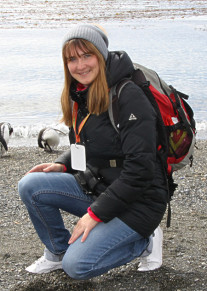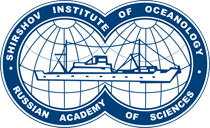 PhD (Geological and Mineralogical Sciences)
PhD (Geological and Mineralogical Sciences)
Senior Researcher
Laboratory of Paleoceanology
Marine Geology
36, Nakhimovskiy prospect, Moscow, 117997, Russia
+7(495)129-21-63
Scopus Author ID: 25653153700
Researcher ID: M-7743-2016
ORCID: 0000-0002-2555-1883
SPIN-code: 3838-9724
ResearchGate: Ekaterina A. Ovsepyan
Education
2015 – PhD in Oceanology, Shirshov Institute of Oceanology Russian Academy of Sciences, PhD Thesis “Correlation of paleoceanographic events between high and low latitudes in the Pacific Ocean over the last glacial-interglacial cycles” (supervisor Dr. Elena V. Ivanova);
2007- 2012 – post-graduate student in Oceanology, Shirshov Institute of Oceanology, Russian Academy of Sciences (supervisor Dr. Elena V. Ivanova);
2007 – MSc in Paleontology, Moscow State University, Master’s Thesis “Late Quaternary benthic foraminiferal assemblages from the Cocos Ridge (Eastern Equatorial Pacific) and their paleoecological interpretation” (supervisor Dr. Elena Ivanova, Shirshov Institute of Oceanology RAS);
2005 – BSc in Paleontology, Moscow State University, Bachelor’s Thesis “The vertical distribution of living and died benthic foraminifera in the upper 10cm of sediments in respond to different ecological factors in the Barents Sea” (supervisor Dr. Elena Ivanova, Shirshov Institute of Oceanology RAS);
2001-2007 - student of Moscow State University (Geological Department, Chair of Paleontology).
Academic experience
2005, 2006 – visiting scientist at Bjerknes Centre for Climate Research, University of Bergen, Norway (1 month);
2009 – 1-week course “2nd International Course on Benthic Foraminifera”, University of Urbino, Urbino, Italy;
2010, 2011, 2012, 2014, 2015 – visiting scientist at 2 weeks stay at the GEOMAR Helmholtz Centre for Ocean Research Kiel, Kiel, Germany and the Alfred Wegener Institute, Helmholtz Centre for Polar and Marine Research, Bremerhaven, Germany;
2010, 2011, 2012, 2014, 2015 – research fellow in the Russian-German Research Program of the Otto-Schmidt Laboratory, St. Petersburg, Russia.
Research interests
- Spatial distribution of recent benthic foraminiferal assemblages and its relation to environmental conditions in the East Siberian Sea;
- Studying of benthic foraminifers as proxies of paleoceanographic conditions;
- High-resolution multiproxy reconstructions of oceanographic conditions in the Bering Sea during two last glacial cycles;
- Paleodynamics of the Oxygen Minimum Zones in the North Pacific;
- Possible mechanisms of teleconnections in the Pacific and Atlantic Oceans;
- Paleogeography and paleooceanology of the Arctic, Pacific and Atlantic Oceans.
Main results (2021)
In cooperation with French colleagues, past bottom water oxygenation was quantitatively assessed through a new, fast, semi-automated, and taxon-independent morphometric analysis of benthic foraminiferal tests, developed and calibrated using western North Pacific, including its marginal seas (WNP), eastern North Pacific (ENP), and eastern South Pacific (ESP) OMZ samples (Tetard, Licari, Ovsepyan et al., 2021a). This new approach is based on an average size and shape index for each sample. This method, as well as two already published micropalaeontological techniques based on benthic foraminiferal assemblages' variability and porosity investigation of a single species, was calibrated here based on availability of new data from 45 core tops recovered along an oxygen gradient (from 0.03 to 2.88 mL L−1) from the WNP, ENP, EEP (eastern Equatorial Pacific), ESP, SWACM (southwest African continental margin), and AS (Arabian Sea) OMZs. Global calibrated transfer functions are herein proposed for these methods. These micropalaeontological reconstruction approaches were then applied to a palaeorecord from the ENP OMZ to examine the consistency and limits of these methods, as well as the relative influence of bottom and pore waters on these micropalaeontological tools. Both the assemblage and morphometric approaches (which are also ultimately based on the ecological response of the complete assemblage and faunal succession according to BWO) gave similar and consistent past BWO reconstructions, while the porosity approach (based on a single species and its unique response to a mixed signal of bottom and pore waters) showed ambiguous estimations.
Furthermore, a new approach to quantitatively reconstruct past bottom water oxygenation was developed, based on the relative abundance of a single benthic foraminiferal species: Eubuliminella exilis (Cushman 1927) (Tetard, Ovsepyan, Licari, 2021b). A taxonomic review as well as a systematic revision of this taxa, previously assigned to the genus Buliminella Cushman 1911, and synonymized with Eubuliminella exilis (Brady 1884), was also carried out. The method was calibrated using 25 core tops recovered from the Western North Pacific (WNP), the Eastern North Pacific (ENP), the Eastern Equatorial Pacific (EEP), Eastern South Pacific (ESP) and the Arabian Sea (AS) OMZs. It was then applied to five cores from the WNP, and ENP OMZs. Data show a similar and consistent relationship with past [O2] values estimated by using the assemblages method developed in previous studies. We thus propose that the relative abundance of Eubuliminella tenuata (Cushman 1927) could be used as a global proxy for estimating past dissolved oxygenation.
Based on the newly developed method, the absolute oxygen concentrations have been calculated in intermediate and deep waters of the Bering Sea during the last 22 kyr (Ovsepyan et al., 2021). Authors found evidences for remote paleoclimatic and paleoceanographic signals from the North Atlantic and Southern Ocean. Obtained data demonstrate asynchronous variations in the oxygen concentrations in intermediate and deep waters probably due to different mechanisms (atmospheric transmission and oceanic tunneling) that have controlled oxygen content at various depths in the North Pacific. It has been suggested that a semi-enclosed position of the Bering Sea and sea-level oscillations might significantly contribute to the magnitude of oxygenation changes in the study area during the last deglaciation. Interregional correlation of different proxy data from a wide range of water depths indicates that deglacial oxygenation changes were more pronounced in the Bering and Okhotsk marginal seas than along the open-ocean continental margin and abyssal settings of the North Pacific.
Projects
RSF № 22-27-00566 “Foraminifers and ostracods as indicators of the modern environmental conditions and paleoenvironments based on materials from the East Siberian Sea” (2022-2023), principal investigator;
RSF №18-17-00227 "Pliocene-Quaternary contourites in the Central and South Atlantic" (2018-2020), performer;
RFBR №16-35-60063 "MIllennial-scale events in the Middle Pleistocene - Holocene history of the Bering Sea based on micropaleontological, lithological and geochemical data" (2016-2018), principal investigator;
RFBR №17-305-50008 "Impact of climate variability on the paleoceanographic conditions in the Rio Grande Rise area (western South Atlantic) during the last three glacial-interglacial cycles based on benthic foraminiferal assemblages ", (2017), principal investigator;
President Grant МК-909.2017.5 "Neogen-Quaternary sedimentation on the Ioffe Drift (western South Atlantic)" (2017-2018), performer;
RSF №14-05-00095 "The World Ocean in the ХХI century: climate, ecosystems, resources, catastrophes» (2015-2018), performer;
RSF №14-17-00697 "Balance of heat and mass of the World Ocean during the last five decades: closure problems and climate variability" (2015-2016), performer;
RFBR №16-35-50080 "Reconstructions of paleoceanographic conditions in the western South Atlantic (Rio Grande Rise) during the Late Quaternary based on benthic foraminiferal assemblages", (2016), principal investigator.
Expeditions
Barents Sea by the RV Professor Shtockman (2004);
Transatlantic expeditions by the RV Akademik Ioffe (2013, 2015, 2016)



